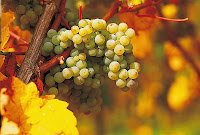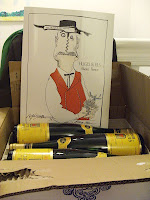So Much Wine Overload Awesomeness
This week's wine class was short because of the tasting exam that took up the first portion of it. That, however, didn't stop us from tasting ten wines, on top of the six we did for the test. The wines we tasted this week were Riesling and Grenache - two that I almost always enjoy. It was kind of a shame that we only tasted five of each!

All of the Rieslings we tried were quite delicious. Riesling seems to be often associated with sweetness, and while it can be used to make some of the most delicious sweet wines - especially from Canada and Germany in their icewines - I think I love it most when used to make refreshing, delicate, vibrant dry wines. I've mentioned delicious dry Rieslings many a time in this blog! We tasted both on Monday; three dry and two sweeter. I say 'sweeter' because these wines were both from Germany, and were made in the Spatlese style. Germany has a somewhat complicated system of rating sweetness in wines, with overlapping residual-sugar-content categories. Spatlese is technically a category below Auslese in sweetness, but high-sugar Spatlese overlaps with low-sugar Auslese within their categories. So Spatlese can be off-dry to semi-sweet, while Auslese can be semi-sweet to sweet.
 The second Spatlese wine we tried was truly fantastic, and walked the line between off-dry and semi-sweet. It was the (get ready for this name) Weinguter Wegeler Wehlener Sonnenuhr Rielsling Spatlese, 2008, from Mosel in Germany. It was a lovely golden colour, and slow and heavy in the glass. It smelled like pie crust, mint, yeast, and sweetmeats, with floral and buttery aromas joining in too. The palate was voluptuous, in a fresh peaches baked in brown sugar and oatmeal way. It had a lovely toasted, coconutty mid-palate which become a lovely vanilla brûlée finish. The trick with sweet wines is that sometimes they lack the structure to balance the sweetness. Not so here - this wine has plenty of acidity to balance out the sugar, and it left my mouth feeling fresh. For $30 it's even a(n almost) reasonable every-day drinking wine!
The second Spatlese wine we tried was truly fantastic, and walked the line between off-dry and semi-sweet. It was the (get ready for this name) Weinguter Wegeler Wehlener Sonnenuhr Rielsling Spatlese, 2008, from Mosel in Germany. It was a lovely golden colour, and slow and heavy in the glass. It smelled like pie crust, mint, yeast, and sweetmeats, with floral and buttery aromas joining in too. The palate was voluptuous, in a fresh peaches baked in brown sugar and oatmeal way. It had a lovely toasted, coconutty mid-palate which become a lovely vanilla brûlée finish. The trick with sweet wines is that sometimes they lack the structure to balance the sweetness. Not so here - this wine has plenty of acidity to balance out the sugar, and it left my mouth feeling fresh. For $30 it's even a(n almost) reasonable every-day drinking wine!.jpg) The Southern Rhone is the home and king of Grenache. While other areas - particularly Spain - make great wines with Grenache, this grape is as inseparable from the Rhone as Chardonnay is from Burgundy. It loves hot-but-not-too-hot areas, dry areas, and lots of huge chunky rocks around to emit heat through cool evenings. Grenache is also a master-blender. Most of the appellations in the Rhone allow blending, and though wines in the Southern Rhone showcase Grenache as the main varietal (even up to 90% of the wine) a variety of other grapes are permitted to modify the wine's character.
The Southern Rhone is the home and king of Grenache. While other areas - particularly Spain - make great wines with Grenache, this grape is as inseparable from the Rhone as Chardonnay is from Burgundy. It loves hot-but-not-too-hot areas, dry areas, and lots of huge chunky rocks around to emit heat through cool evenings. Grenache is also a master-blender. Most of the appellations in the Rhone allow blending, and though wines in the Southern Rhone showcase Grenache as the main varietal (even up to 90% of the wine) a variety of other grapes are permitted to modify the wine's character.

*****
On another note, this was a super exciting day for me. Four cases of wine were delivered to my doorstep! Two of Hugel Gentil and two of Luigi Righetti Campolieti Valpolicella Ripasso. Holy crap, I'm SO EXCITED.

 On the left, Hugel, and their funny man poster! On the right, Righetti, looking elegant!
On the left, Hugel, and their funny man poster! On the right, Righetti, looking elegant!


Comments
Post a Comment